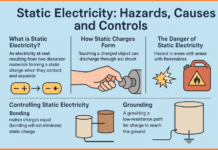Contents
Triangle of fire
According to old concept, three elements are necessary to start fire. They are (1) Fuel (2) Oxygen and (3) Heat or Source of ignition. Fire is not possible if any one of these elements is not available. This is shown.

Pyramid of Fire
According to this concept, four elements are necessary to start fire. They are as under-
(1) Fuel (Combustible material and reducing agent)
(2) Oxygen or oxidant or oxidizer (from the atmosphere)
(3) Heat or source of ignition (necessary to start the fire initially, but maintained by the fire itself once it has started and
(4) Chain reaction through free radicals to maintain the fire.
CLICK HERE FOR > SURAT FIRE CASE STUDY

If any one of above four elements is removed, the fire goes out. Therefore, methods of fire extinguishment are dependent on:
(1) Removing or shutting off the source of fuel.
(2) Excluding oxygen or decreasing it below 14 to 18% by adding inert gases.
(3) Removing heat from the fire faster than its liberation and
(4) Removing free radicals to discontinue chain reaction and flame propagation. Dry powder chemicals and halogenated hydrocarbons capture free radicals and put out fire in this way.
CLICK HERE FOR > FIRE LOAD FORMULA
What is Fire
Thus fire is a rapid chemical oxidation reduction reaction. Oxygen in air acts as an oxidizer and fuel acts as a reducing agent and burning material. It is an oxidation of a substance (which burns fuel) accompanied by heat, light and flame. Due to incomplete combustion it evolves smoke and carbon monoxide which creates invisibility and toxic atmosphere for fire fighters.
An excess of air can cool the combustion gases to quench the fire, if the combustible material is small, otherwise it cannot, as in case of forest fire where the combustible material is too much to cool.
The chemical reaction is exothermic as it evolves heat and the heat released is used for the reaction to continue.
Fire is a burning or combustion phenomena and the combustion may be kinetic or diffusive depending upon homogenous or inhomogeneous air-fuel mixtures.
The combustion may be complete or incomplete. The complete combustion gives product like CO2, SO2, water vapour etc., which cannot burn any more. The incomplete combustion (due to insufficient or blocked air) gives CO, alcohol, aldehydes etc., which can burn further more.
Stage of Fire
Mostly fire develops in four stages as under-
(1) Incipient stage – No visible smoke, flame or more heat developed. Invisible combustion particles are generated over a period of minutes, hours or days. Ionisation detectors respond to these particles.
(2) Smouldering stage – Visible smoke generation Photoelectric detectors can detect this smoke.
(3) Flame stage – Flame starts after point of ignition smoke decreases and heat increase. Infrared detectors can detect this stage.
(4) Heat stage – Heat, flame, smoke and gases are produced in large amount. Thermal detectors respond to this stage.
CLICK HERE FOR > PORTABLE FIRE EXTINGUISHER
Spread of Fire
It depends on the following factors:
(1) The area of the substance exposed;
(2) The amount of heat generated or given off by the burning substance;
(3) The ability of the substance to conduct the heat away from the zone of combustion;
(4) The atmospheric humidity and the wind velocity.
Thus fire will spread more if more combustible area is available, if more heat is given by the burning material, if more heat conduction is possible and if atmospheric humidity is less and wind speed is high.
It is important to prevent or reduce the spread of fire.
CLICK HERE FOR > Tariff Advisory Committee (TAC)






Good job sir
Thanks sir